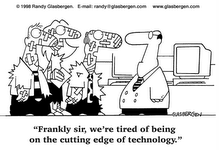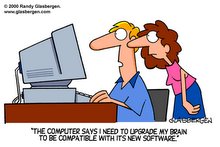On March 25 and 26, 2009, in Washington DC (well, actually, in Crystal City, Virginia), I attended the first SOA Consortium conference for the year 2009. The Service Oriented Architecture (SOA) Consortium is an advocacy group. When the group formed, to expedite and gain infrastructure efficiencies, , the group’s founding sponsors and members decided that it made fiscal sense to be managed by the Object Management Group (OMG). Therefore, the SOA Consortium always cohabitates with OMG; however, these organizations have completely different missions. For one, the SOA Consortium does not do standards work. The SOA Consortium members are a mix of end-users (mostly Fortune 200), vendors and service providers. The group’s mission is to simply evangelize SOA in the context of business value generation and to enable successful (and sustainable) SOA adoption. The organization’s website is: http://www.soa-consortium.org.
I discovered this group about a year ago. In this group, I have met many of the SOA gurus whose work I have been following for the past few years: gurus such as Thomas Erl (whose latest book published in December 2008 I have yet to read even as it sits on the banister by my front door as a constant reminder to be picked up), David Linthicum, Richard Mark Soley, and others. I discovered yesterday that a set of Enterprise Service Bus (ESB) criteria and evaluation reports that I have found useful the last several years when comparing ESB products was actually written by Brenda Michelson, a woman with whom I have been engaged in conversation over the past year. Yesterday I also met one of the two co-founders of ZapThink, and the creator of a well-known SOA poster which I have seen papered on several colleagues’ office walls (including my own on occasion). In spite of the popularity of some of the members of the consortium, I have found that the meetings tend to be quite small (always less than 30 people and usually more like a dozen). Because of their coziness, these meetings have given me the opportunity to have good discussions with authors, industry analysts and presenters, methodologists, bloggers, professors, business executives, vendors, product/methodology trainers, and other highly credentialed SOA evangelists.
The March 2009 meeting started with a brief introduction by Dr. Richard Mark Soley, Chairman and Chief Executive Officer of OMG. David Linthicum, Northrop Grumman's very own Scott Tucker’s brother-in-law, is an internationally known author and application integration and SOA expert. He spoke of the intersections between SOA and Cloud Computing. The gist of his argument was that it was imperative that we each start to elevate the importance, experimenting and adoption of cloud computing. Next, Sandy Carter, author and Vice-President of IBM’s SOA and WebSphere Strategy spoke on how SOA can help in today’s tough economic climate. Sandy’s latest book is “The New Language of Marketing 2.0 – How to Use ANGELS to Energize Your Market”. The title of the book is kind of funky but is an acronym for her marketing approach:
• Analyze and ensure strong market understanding
• Nail the relevant strategy and story
• Go to Market Plan
• Energize the channel and community
• Leads and revenue
• Scream!!! Don’t forget the Technology!
You will have to read the book (or at least quickly scan it on amazon.com) to learn more about her marketing approach and I guess to have her acronym make sense. I do not consider myself a salesperson although that really is at least *part* of my job description. However, I need to pay more attention to the technical side of this SOA story. I have long been sold on its business case.
Speaking of books, another book I heard about was “SOA Governance” by Todd Biske. This is yet another book on SOA on which I will have to at least peek.
After a morning break, we attended a roundtable discussion on SOA in a Green World. Brenda had mentioned this in a previous teleconference, and, while “green” is today’s color of choice, I am yet to be convinced that there is a strong connection between SOA and its potential promise to avert climate change.
Carter pointed out that economic conditions are causing businesses to take a harder look at the efficiencies of their processes. Carter suggested that a byproduct of that scrutiny will be greater energy savings in IT and other parts of companies. Linthicum agreed that SOA and cloud computing will deliver more efficient, and thus, greener processes. However, he added, green is a byproduct of process automation or improvement, not the reason for adopting new approaches.
Someone commented that as we endeavor to make IT “greener,” we should weigh the benefits that IT has already brought to the planet. For example, how many trees have been saved due to paperless processing, Electronic Data Interchange (EDI), and online communication? How much oil and energy has been saved because of telecommuting and teleconferencing? How many stores and shopping malls have not been built due to the rise of electronic commerce? And what about the economic benefits that IT has brought? For example, how many people no longer needed to be uprooted from their communities in order to attend good schools and universities or get a good job? Thus, while SOA can play a leading role in the greening of our world, we need to understand how many resources have actually been saved, and gained, as the physical world has been displaced by the digital/virtual world – probably far more than the energy that computers have consumed.
By the way, in 2008, a group formed who call themselves the Green Computing Impact Organization (GCIO). This group is managed by The Object Management Group and works with the BPM Consortium and the SOA Consortium. This group’s website is at http://gcio.org. This group’s mission as stated on their website is:
“Be an active participant in transforming the enterprise business community from an environmental liability to an Earth conscious example of responsibility. We do so through our collaborative membership programs and initiatives which bring together enterprise business and IT executives, visionaries, pundits, authorities and practitioners all with a vested interest in the promotion and adoption of sustainable business practices. As a community, our members and sponsors provide the foundational information a company needs to make business sustaining and environmentally responsible decisions and directions. We work with all facets of industry and government operations as well as educational institutions and complimentary non-profit agencies.”
Cory Casanave, Board of Directors at OMG, President at Model Driven Solutions, Inc., in Vienna, Virginia, and a leader in Model Driven Enterprise Architecture (MDA), SOA and Semantic Web, introduced a new template (or profile) extension for UML called SOA Modeling Language (SoaML). Yes, another modeling language! The SoaML (it bothers me a bit to type Capital “S” with lower-case “oa” as I am so accustomed to typing “SOA” in all upper-case) is defined as a “specification [which] describes a UML profile and metamodel for the design of services within an SOA”. According to the agenda: “The SoaML profile supports the range of modeling requirements for SOA, including the specification of systems of services, the specification of individual service interfaces, and the specification of service implementations. This is done in such a way as to support the automatic generation of derived artifacts following a [Model-Driven Architecture] based approach.” My only thought on this is that this is yet something else to be explored.
JP Morgenthal presented an interesting yet, for me at least, a somewhat irritating talk on the relationship (or lack thereof) between SOA and Business Process Management (BPM). Morgenthal, a senior analyst at the Burton Group and former chief architect at Software AG, suggested that the industry has placed too much emphasis on the relationship between BPM and SOA. He felt that the two were completely unrelated and one did not necessarily help the other and that the two didn’t even need to be considered in parallel. I listened to his rant and told him that I disagreed with his thesis. In general, he seemed to enjoy being the contrarian and I had the feeling that any notion that any two or more people agreed on, he would have enjoyed playing the devil’s advocate. A little side argument that arose was the distinction of enterprise SOA and non-enterprise SOA. When does something indeed qualify to become true “enterprise-level” SOA?
A few vendors (less than a dozen—I didn’t get too many chances to freshen my ink pen collection) had booths. Among these was a booth for MagicDraw advertising an announcement dated March 23, 2009: “Cameo SOA+ 16.0 beta 1 is released”. See the following for more information: "Newly released Cameo™ SOA+ leverages the latest Model Driven Architecture® (MDA® ) standards and technologies making the transition from model to implementation highly automated, reducing implementation and maintenance costs. Cameo™ SOA+ supports all standard SoaML diagrams. Cameo™ SOA+ is packaged as a plugin to the MagicDraw® tool and is available for purchase separately. The Cameo™ SOA+ retains all capabilities of award-winning MagicDraw architecture modeling environment adding a SOA specific perspective."
I did grab a copy of the latest trial version of Enterprise Architect and as assortment of white papers and other materials. Guess I did not fully do my job as being a green SOA Consortium member since I took these printed materials. I grabbed two business cards for Northrop Grumman’s Stanley King, an engineer who works in the area of first response management. NEC Sphere Communications, showed a compelling demo of web 2.0 technology in a first responder scenario.
An important thing to note is that the SOA Consortium has been working on developing what they call a “Business-Driven SOA Planning Framework”. The goal of this framework is to identify the major business-driven SOA activities and to provide guidance on planning and executing those activities.
The next SOA Consortium is one I would really love to attend but imagine will have a hard time selling to my manager as it will be held at the Real InterContinental Hotel on June 24 and 25, 2009, in San Jose. That is San Jose, Costa Rica; not California.
Thursday, April 2, 2009
Subscribe to:
Post Comments (Atom)



No comments:
Post a Comment